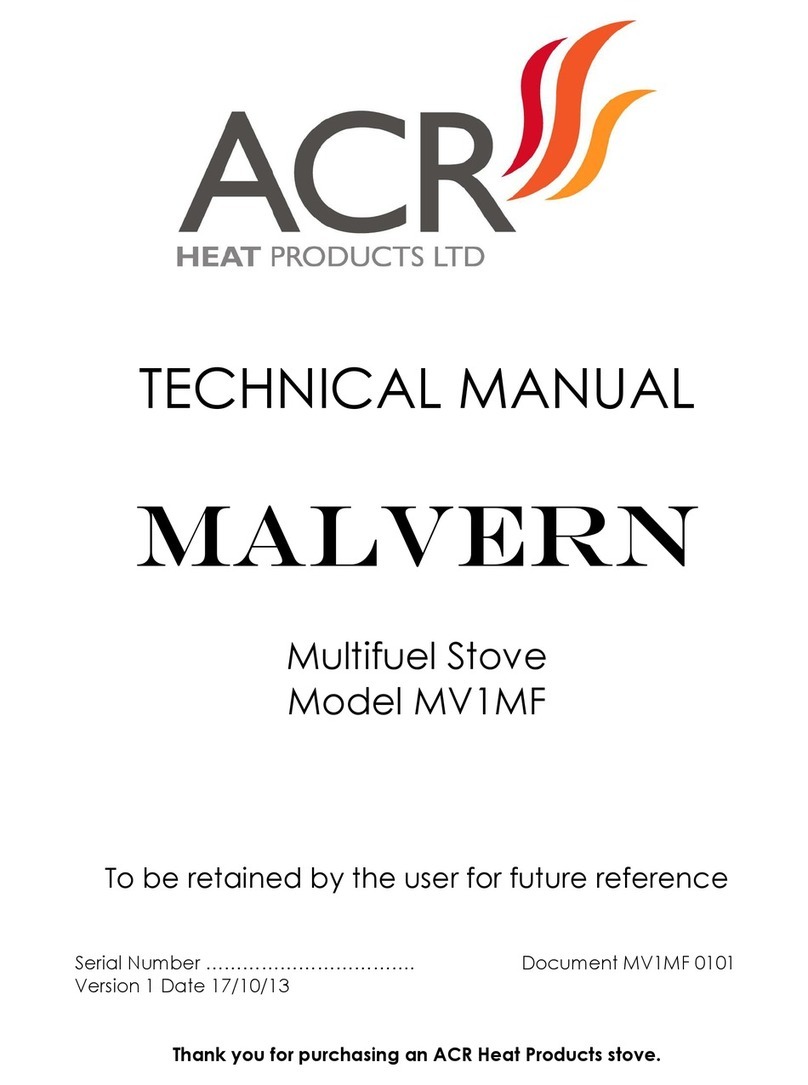Operating your stove
Instructions for use with
wood
• Pull the secondary air slider (marked
with a double hole) fully forward and
open the primary air slider (marked
with a single hole) fully by pulling the
lever forward.
• Pull the tertiary air slider (Marked with
no holes located under the body of the
appliance) out by approximately 50%
• Lay firelighters or rolled up
newspapers on the grate and add a
small amount of kindling wood to the
top. Place 1 or 2 small logs on the
top.
• Light the newspaper or firelighters
using a long taper and push the door
closed but do not engage the locking
handle fully.
• When the fire is burning fiercely, after a
couple of minutes add more logs and
close the door.
• When the fire has become established,
close the primary air (marked with a
single hole) down by pushing the lever
inwards.
• The burning rate can be altered by
moving the secondary air slider
(marked with a double hole) - push the
lever inwards to close down and pull
outwards to increase the burn rate.
• Care should be taken to ensure that
the logs are not placed higher than
the log guard allows. This stove
features a split log guard to allow
differing loads to be managed, only
alter the log guard when the appliance
is fully cold.
Instructions for use with
smokeless fuel
• Pull the secondary air slider (marked
with a double hole) under the ashlip
and open the primary air slider
(marked with a single hole) fully by
pulling the lever forward.
• Make sure that the tertiary slider
(Marked with no holes located under
the body of the appliance) is fully
pushed in.
• Lay firelighters or rolled up
newspapers on the grate and add a
small amount of kindling wood to the
top. Place a small quantity of
smokeless fuel on top.
• Light the newspaper or firelighters
using a long taper and push the door
closed but do not engage the locking
handle fully.
Operating your stove
• When the fire is burning fiercely, after a
couple of minutes add more
smokeless fuel and close the door.
• When the fire has become established,
close the secondary air (marked with a
double hole) down by pushing the
lever inwards.
• The burning rate can be altered by
moving the primary air slide (marked
with a single hole) - pull forward to
fully open and push inward to close
down.
• Care should be taken to ensure that
the firebox is not overfilled with
smokeless fuel - it should be no
higher than the log guard. This stove
features a split log guard to allow
differing loads to be managed.
Re-fueling
When refueling the stove always refuel
onto a bed of hot embers, fully open
the secondary and primary air controls
until the new fuel is well alight, before
adjusting the air controls for the desired
setting.
If there is insufficient burning material in
the firebed to light a new fuel charge,
excessive smoke emission can occur.
Refuelling must be carried out onto a
sufficient quantity of glowing embers
and ash that the new fuel charge will
ignite in a reasonable period. If there are
too few embers in the fire bed, add
suitable kindling to prevent excessive
smoke.
Fuel overloading
Never overload the stove - it will work
very well with two medium sized logs.
The amount of fuel specified in this
manual should not be exceeded,
overloading can cause excess smoke.
Operation with door left open
Operation with the door open can cause
excess smoke. The appliance must not
be operated with the appliance door left
open except as directed in the
instructions.
Air controls left open
Operation with the air controls or
appliance dampers open fully can cause
damage to the appliance. The appliance
must not be operated with air controls,
appliance dampers or door left open
except as directed in the instructions.
• Never leave the stove unattended
until the new fuel is well alight.
Persistent fume emission is
dangerous and must be investigated.
If fume emission persists, open doors
and windows to ventilate the room and
let the fire die. Have the chimney
inspected for blockages and clean if
required. Do not relight the fire until the
cause has been found. We recommend
that you seek professional advice.
This appliance has been designed to
be burned with the door closed at all
times other than when refueling.
It should not be operated as an open
fire.
Typical refueling intervals for wood is
1 hour and smokeless fuel is 2 hours.
Daily Maintenance
The ashpan should be checked and
emptied regularly.
• You should never allow the ashes in
the pan to build up to the level of
the grate.
If they are allowed to build up, the grate
will become sandwiched between the
ash below it and above it. This will
overheat the grate and cause distortion
and premature wear.
A
A
B
B
CC
C
A
B




























